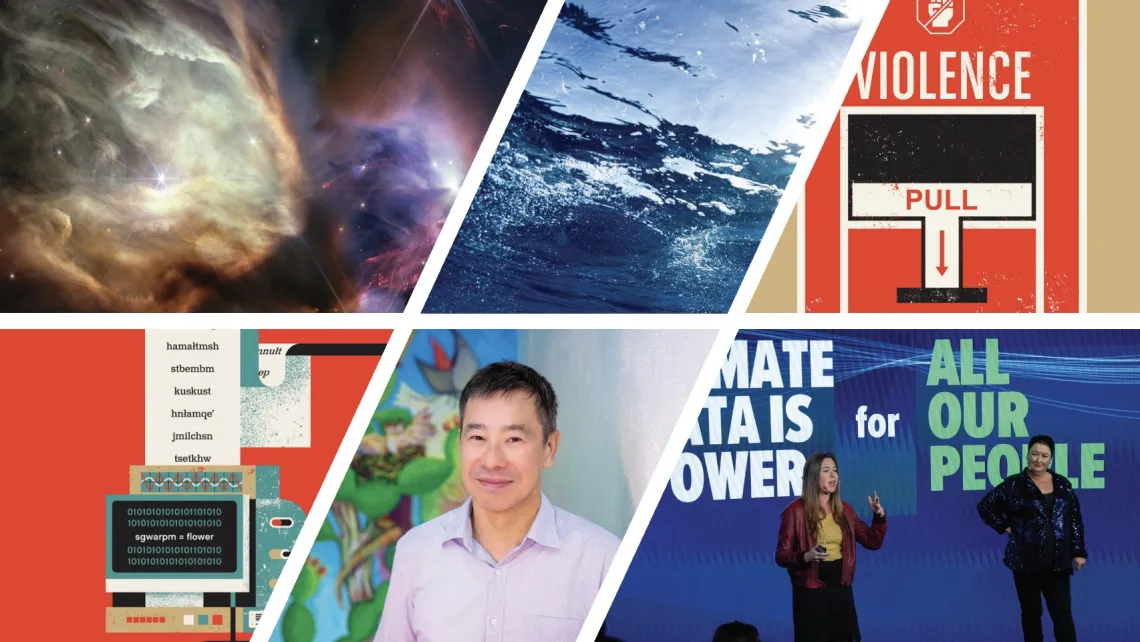Data Connects Us – Spotlight on SBS Research

Researchers in the College of Social and Behavioral Sciences are merging big data and artificial intelligence to advance innovative, interdisciplinary solutions to social issues, including endangered Indigenous languages, political violence, AI in education, climate change, and addressing the decrease in scientific breakthroughs.
"Data Connects Us” – a report produced by University of Arizona Research, Innovation & Impact and the Institute for Computation & Data-Enabled Insight – spotlights six SBS projects that illustrate how big data and AI are part of the College of SBS’s diverse methodological toolkit, helping us understand the complexity of people in the world and shape a better, more just, future.
Technology Brings New Tools to Revitalizing Endangered Languages
Researchers in the Department of Linguistics are partnering with UArizona’s American Indian Language Development Institute, or AILDI, to ensure linguistic heritage is restored and preserved through collaborative endeavors with Indigenous communities, leveraging big data, machine learning, and technology. This intersection of linguistics and AI not only fortifies endangered languages but also contributes to the broader understanding of human communication.
[The collaboration between linguists and AILDI] created a web application that is being trained on Coeur d’Alene words as a path to mastering the language more broadly. With machine learning, the application will eventually be able to independently build its command of the language by scanning texts to learn more advanced grammar and syntax. Those scanned materials also become part of a master archive, opening doors to a trove of potential research that relies on databases of digitized text.
Tracking the Threat of Political Violence in Real Time
Javier Osorio, assistant professor in the School of Government and Public Policy, co-led the National Science Foundation grant-funded research project ConfliBERT, an AI tool designed to forecast and prepare for violent unrest, underscoring UArizona’s commitment to addressing complex societal challenges.
ConfliBERT far outperforms general natural language processing tools in spotting and analyzing red flags for conflict and violence, with applications for both predicting unrest and learning from past incidents.
Navigating AI in Education
Sandiway Fong, director of the Human Language Technology Program in the Department of Linguistics, is pragmatic about the use of AI tools by students. He embraces AI and its ability to foster critical thinking and innovation. Fong advocates for the widespread use of AI tools in education and proposes a realistic approach for educators, encouraging them to focus on designing assignments that foster critical thinking rather than attempting to restrict technology use.
My assignments are structured so that students have to think. I think that should be the ultimate criterion, which puts the onus on professors to design work that can’t be accomplished with copy and paste. And I think this is a potential upside: professors could do better, and students could actually end up learning more.
Working for the Future Our Kids Deserve
Beth Tellman, assistant professor in the School of Geography, Development & Environment, uses big data and AI as instruments to conduct impactful research on global warming and flooding, and to help predict environmental changes. Tellman integrates satellite data and machine learning for flood prediction, along with the creation and application of flood maps.
Using satellites, she captures data from flood events around the world and uses machine learning to not only reconstruct past incidents but also develop algorithms that predict flooding and its destruction with increasing accuracy.
Refinement vs. Revelation in Science
Erin Leahey, professor in the School of Sociology, partnered with researchers from the University of Minnesota, leveraging AI to study a huge amount of information to understand how science research is done. She hopes to encourage more groundbreaking discoveries by focusing on quality, giving scientists time to explore, and supporting career-focused funding.
[The team gathered] data on 49 million patents and scientific papers over the past 60 years and used computational techniques to analyze their citation patterns. They found that scientists are working with increasingly narrow slices of knowledge in a trend toward incrementally consolidating earlier work – better versions of earlier equations, for example, versus the revelation of DNA’s double-helix.
##
Partial content taken from “Data Connects Us,” a Fall 2023 publication of the University of Arizona Research, Innovation & Impact and Institute for Computation & Data-Enabled Insight.

